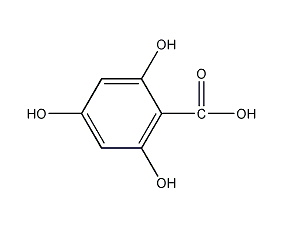
Structural formula
| Business number | 01TL |
|---|---|
| Molecular formula | C7H6O5 |
| Molecular weight | 170.12 |
| label |
Phloroglucinol formic acid, 2,4,6-Trihydroxybenzoic acid monohydrate, Phloroglucinol carboxylic acid, Phloroglucinic acid, Phloroglucinolcarboxylic acid |
Numbering system
CAS number:83-30-7
MDL number:MFCD00002453
EINECS number:201-467-5
RTECS number:DH8910000
BRN number:2212148
PubChem number:24889588
Physical property data
1. Physical property data
1. Character: Uncertain.
2. Density (g/mL,25/4℃) : Unsure
3. Relative vapor density (g/mL,AIR=1): Unsure
4. Melting point (oC):210
5. Boiling point (oC,Normal pressure): Uncertain
6. Boiling point (oC,5.2kPa): Unsure
7. Refractive index: Uncertain
8. Flash Point (oC): Unsure
9. Specific optical rotation (o): Unsure
10. Autoignition point or ignition temperature (oC): Unsure
11. Vapor pressure (kPa,25oC): Unsure
12. Saturated vapor pressure (kPa,60oC): Unsure
13. Heat of combustion (KJ/mol): Unsure
14. Critical temperature (oC): Unsure
15. Critical pressure (KPa): Unsure
16. Oil and water (octanol/Log value of water) partition coefficient: Uncertain
17. Explosion limit (%,V/V): Unsure
18. Lower explosion limit (%,V/V): Unsure
19. Solubility: Uncertain.
Toxicological data
Acute toxicity:
Mouse abdominal cavity LD50: >800 mg/kg;
Ecological data
None
Molecular structure data
None
Compute chemical data
1. Reference value for hydrophobic parameter calculation (XlogP): None
2. Number of hydrogen bond donors: 4
3. Number of hydrogen bond acceptors: 5
4. Number of rotatable chemical bonds: 1
5. Number of tautomers: 15
6. Topological molecule polar surface area 98
7. Number of heavy atoms: 12
8. Surface charge: 0
9. Complexity: 169
10. Number of isotope atoms: 0
11. Determine the number of atomic stereocenters: 0
12. Uncertain number of atomic stereocenters: 0
13. Determine the number of chemical bond stereocenters: 0
14. Number of uncertain chemical bond stereocenters: 0
15. Number of covalent bond units: 1
Properties and stability
None
Storage method
None
Synthesis method
None
Purpose
None
extended-reading:http://www.mimgu.com/archives/40538extended-reading:https://www.bdmaee.net/niax-potassium-octoate-trimer-catalyst-momentive/extended-reading:https://www.cyclohexylamine.net/elastomer-environmental-protection-catalyst-nt-cat-e-129/extended-reading:https://www.bdmaee.net/low-odor-reactive-composite-catalyst/extended-reading:https://www.bdmaee.net/monobutyltin-trichloride-cas1118-46-3-trichlorobutyltin/extended-reading:http://www.mimgu.com/archives/44983extended-reading:https://www.bdmaee.net/dabco-t-16-catalyst-cas10102-43-9-evonik-germany/extended-reading:https://www.bdmaee.net/wp-content/uploads/2020/06/65.jpgextended-reading:https://www.bdmaee.net/wp-content/uploads/2022/07/2212.jpgextended-reading:https://www.cyclohexylamine.net/light-foam-catalyst-polyurethane-heat-sensitive-delay-catalyst/
]]>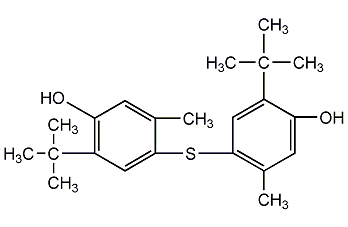
Structural formula
| Business number | 02BD |
|---|---|
| Molecular formula | C22H30O2S |
| Molecular weight | 358.53 |
| label |
5-tert-butyl-4-hydroxy-2-methylphenylene sulfide, 4,4′-Thiobis(3-methyl-6-tert-butyl)phenol, Anti-aging agent 300, 5-tert-butyl-4-hydroxy-2-methyl phenyl sulfide, Antioxidants |
Numbering system
CAS number:96-69-5
MDL number:MFCD00026287
EINECS number:202-525-2
RTECS number:GP3150000
BRN number:None
PubChem ID:None
Physical property data
1. Properties: white to yellowish brown powder.
2. Relative density (g/mL, 25/4℃): 1.06~1.12
3 . Relative vapor density (g/mL, air=1): Undetermined
4. Melting point (oC): 161~164
5. Boiling point (oC, normal pressure): Undetermined
6. Boiling point (oC, kPa): Undetermined
7. Refractive index: Undetermined Determined
8. Flash point (oC): 215
9. Specific rotation (o): Undetermined
10. Autoignition point or ignition temperature (oC): Not determined
11. Vapor pressure (mmHg, 20.2oC): Not determined
12. Saturated vapor pressure (kPa, oC): Not determined
13. Heat of combustion (KJ/mol): Undetermined
14. Critical temperature (oC): Undetermined
15. Critical pressure (KPa): Undetermined
16. The logarithmic value of the oil-water (octanol/water) partition coefficient: Undetermined
17. The upper limit of explosion (%, V/V): Undetermined
18. Lower explosion limit (%, V/V): Undetermined
19. Solubility: Soluble in benzene, ethanol, acetone, ether, slightly soluble in petroleum ether, insoluble in water.
Toxicological data
None
Ecological data
None
Molecular structure data
Molecular property data:
1. Molar refractive index: 108.82
2. Molar volume (cm3/mol): 320.3
3. etc. Zhangratong (90.2K): 846.3
4. Surface tension (dyne/cm): 48.7
5. Dielectric constant:
6. Dipole moment (10-24cm3):
7. Polarizability: 43.14
Compute chemical data
1. sparseReference value for water parameter calculation (XlogP): 7.4
2. Number of hydrogen bond donors: 2
3. Number of hydrogen bond acceptors: 3
4 . Number of rotatable chemical bonds: 4
5. Number of tautomers: 21
6. Topological molecule polar surface area 65.8
7. Heavy atoms Number: 25
8. Surface charge: 0
9. Complexity: 396
10. Number of isotope atoms: 0
11. Determine the number of stereocenters of atoms: 0
12. Determine the number of stereocenters of atoms: 0
13. Determine the number of stereocenters of chemical bonds: 0
14. Number of uncertain chemical bond stereocenters: 0
15. Number of covalent bond units: 1
Properties and stability
1. White to brown powder.
2. Soluble in ethanol, benzene, acetone, ether and naphtha, slightly soluble in petroleum ether, insoluble in water.
3. This product has low toxicity.
Storage method
Store in a cool, dry place, pay attention to moisture and avoid high temperature.
Synthesis method
1.Synthesis of 3-methyl-6-tert-butylphenol. Add resorcinol, isobutylene, aluminum trichloride and concentrated sulfuric acid to the reaction kettle, stir and heat to 310~320°C to carry out alkylation reaction. After the reaction is completed, the reaction product is neutralized and distilled to obtain 3-methyl-6-tert-butylphenol.

2.3-Methyl-6-tert-butyl Phenol and sulfur dichloride react at a temperature of 45 to 50°C. After the reaction is completed, it is dissolved with petroleum ether and cooled to crystallize, and then filtered, washed, and dried to obtain the finished product.

Purpose
This product is a highly efficient and multi-functional sulfur-containing hindered phenolic antioxidant. Due to its excellent structure, this product has dual functions of primary and auxiliary antioxidants. It has a good synergistic effect when used with carbon black. Therefore, it is widely used in plastics, rubber, petroleum products, and rosin resin (antioxidation and color reduction). Especially for polyethylene wire and cable materials (such as communication cable sheath materials, insulation materials, chemical cross-linked polyethylene insulation materials, semi-conductive shielding materials, silane cross-linked polyethylene cable materials, etc.) and high-density polyethylene pipe materials, outdoor use Other black polyethylene materials, etc., have more unique effects. Therefore, it enjoys the reputation of “special antioxidant for polyethylene cable materials and pipe materials” abroad. When used for low-density polyethylene, the added amount is 0.05 parts; for high-density polyethylene, the added amount is 0.25 parts. This product does not pollute or discolor after being added. It can be mixed directly into rubber or made into a water dispersion for latex. In addition, it can also be used in ABS resin. A large amount of test data and practice have confirmed that this product has a good synergistic effect when used in conjunction with carbon black and ultraviolet absorbers such as benzophenone UV-531 and benzotriazole Tinuvin-327.
Used as a non-polluting anti-aging agent for natural rubber, styrene-butadiene rubber, butadiene rubber, nitrile rubber, chloroprene rubber, silicone rubber
agent, the reference dosage is 0.5 to 1 part (mass part). It can also be used as polyethylene antioxidant; when used for low-density polyethylene, the added dosage is 0.05 parts; when used for high-density polyethylene, the added dosage is 0.25 parts. It does not pollute, does not discolor, has low volatility, is highly effective in antioxidants, has excellent thermal stability and weather resistance, and can be directly mixed into rubber or made into a water dispersion for latex. Can also be used in ABS resin.
extended-reading:https://www.bdmaee.net/nt-cat-pc520-catalyst-cas10294-43-5-newtopchem/extended-reading:https://www.bdmaee.net/butyl-tin-triisooctoate-cas23850-94-4-butyltin-tris/extended-reading:http://www.mimgu.com/archives/category/products/page/45extended-reading:https://www.bdmaee.net/u-cat-2024-catalyst-cas135083-57-8-sanyo-japan/extended-reading:https://www.bdmaee.net/wp-content/uploads/2020/07/88-1.jpgextended-reading:https://www.bdmaee.net/cas-7646-78-8-2/extended-reading:https://www.bdmaee.net/bis2dimethylaminoethylether/extended-reading:http://www.mimgu.com/archives/category/products/page/23extended-reading:https://www.morpholine.org/dabco-amine-catalyst-low-density-sponge-catalyst/extended-reading:http://www.mimgu.com/archives/920
]]>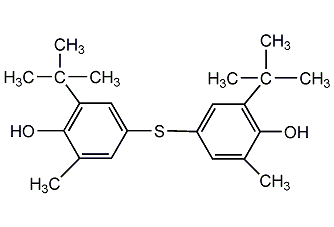
Structural formula
| Business number | 02BC |
|---|---|
| Molecular formula | C22H30O2S |
| Molecular weight | 358.54 |
| label |
None |
Numbering system
CAS number:96-66-2
MDL number:MFCD00008823
EINECS number:202-522-6
RTECS number:GP3200000
BRN number:None
PubChem ID:None
Physical property data
1. Characteristics: Undetermined
2. Density (g/mL, 20℃): Undetermined
3. Relative vapor density (g/mL, air=1 ): Undetermined
4. Melting point (oC): 127
5. Boiling point (oC, normal pressure): Undetermined
6. Boiling point (oC , kPa): Not determined
7. Refractive index: Not determined
8. Flash point (oC): 241
9. Specific rotation (o ): Undetermined
10. Autoignition point or ignition temperature (oC): Undetermined
11. Vapor pressure (mmHg, 20.2oC): Undetermined
12. Saturated vapor pressure (kPa, oC): Undetermined
13. Heat of combustion (KJ/mol): Undetermined
14. Critical temperature (oC): Undetermined Determined
15. Critical pressure (KPa): Undetermined
16. Log value of oil-water (octanol/water) partition coefficient: Undetermined
17 . Explosion upper limit (%, V/V): Undetermined
18. Explosion lower limit (%, V/V): Undetermined
19. Solubility: Undetermined
p>
Toxicological data
Acute toxicity: rat oral LD50: 6340mg/kg; mouse oral LD50: 3mg/kg; mammal oral LD50: 6340mg/kg;
Ecological data
None
Molecular structure data
1. Molar refractive index: 108.82
2. Molar volume (cm3/mol): 320.3
3. Isotonic specific volume (90.2K): 846.3
4. Surface tension (dyne/cm): 48.7
5. Polarizability (10-24cm3): 43.14
Compute chemical data
1. Reference value for hydrophobic parameter calculation (XlogP): 7.4
2. Number of hydrogen bond donors: 2
3. Number of hydrogen bond acceptors: 3
4. Number of rotatable chemical bonds: 4
5. Number of tautomers: 5
6. Topological molecule polar surface area 65.8
7. Number of heavy atoms: 25
8. Surface charge: 0
9. Complexity: 396
10. Number of isotope atoms: 0
11. Determine the number of atomic stereocenters: 0
12. Uncertain number of atomic stereocenters: 0
13. Determine the number of chemical bond stereocenters: 0
14. Number of uncertain chemical bond stereocenters: 0
15. Number of covalent bond units: 1
Properties and stability
None
Storage method
None
Synthesis method
None
Purpose
None
extended-reading:http://www.mimgu.com/archives/category/products/page/11extended-reading:http://www.mimgu.com/archives/40287extended-reading:https://www.bdmaee.net/ethylhexanoic-acid-zinc-salt/extended-reading:https://www.bdmaee.net/trimethylhydroxyethyl-ethylenediamine-cas-2212-32-0-pc-cat-np80/extended-reading:https://www.bdmaee.net/polycat-12-catalyst-cas10144-28-9-evonik-germany/extended-reading:http://www.mimgu.com/archives/44919extended-reading:http://www.mimgu.com/archives/833extended-reading:http://www.mimgu.com/archives/39763extended-reading:https://www.cyclohexylamine.net/category/product/page/27/extended-reading:http://www.mimgu.com/archives/44906
]]>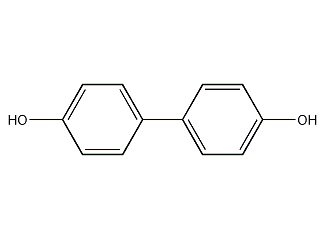
Structural formula
| Business number | 025E |
|---|---|
| Molecular formula | C12H10O2 |
| Molecular weight | 186.21 |
| label |
(1,1′-biphenyl)-4,4′-diol, 4,4′-Diphenol, 4,4′-biphenyldiol, biphenyl, 4,4′-biphenyldiol, (1,1′-biphenyl) -4,4′-diol, 4,4′-phenol, 4,4′ – biphenyl diol, Dihydroxybiphenyl, 4,4′- biphenyl phenol, Anti-aging agent |
Numbering system
CAS number:92-88-6
MDL number:MFCD00002348
EINECS number:202-200-5
RTECS number:DV4725000
BRN number:1908886
PubChem number:24863431
Physical property data
1. Properties: White needle-like or flaky crystals.
2. Relative density (g/mL, 25/4℃): 1.22
3. Relative vapor density (g/mL, air=1): Undetermined
4. Melting point (oC): 280.5
5. Boiling point (oC, normal pressure): Undetermined
6. Boiling point (oC, 5.2kPa): Undetermined
7. Refractive index: Undetermined
8. Flash point (oC): Undetermined
9. Specific rotation (o): Undetermined
10. Autoignition point or ignition temperature (oC): Undetermined
11. Vapor pressure (kPa, 25oC): Undetermined
12. Saturated vapor Pressure (kPa, 60oC): Undetermined
13. Heat of combustion (KJ/mol): Undetermined
14. Critical temperature (oC): Undetermined
15. Critical pressure (KPa): Undetermined
16. Log value of oil-water (octanol/water) partition coefficient: Undetermined
17. Explosion upper limit (%, V/V): Undetermined
18. Lower explosion limit (%, V/V): Undetermined
19. Solubility: Soluble in ethanol and ether, slightly soluble in water and benzene.
Toxicological data
Toxicity classification Highly toxic
Acute toxicity: abdominal cavity – mouse LD50: 100 mg/kg; oral administration – rat LD50: 9850 mg/kg.
Ecological data
Slightly harmful to water.
Molecular structure data
1. Moore’s conversionRatio: 54.60
2. Molar volume (cm3/mol): 151.5
3. Isotonic specific volume (90.2K): 410.6
4. Surface tension (dyne/cm): 53.8
5. Polarizability (10-24cm3): 21.64
Compute chemical data
1. Reference value for hydrophobic parameter calculation (XlogP): None
2. Number of hydrogen bond donors: 2
3. Number of hydrogen bond acceptors: 2
4. Number of rotatable chemical bonds: 1
5. Number of tautomers: 5
6. Topological molecule polar surface area 40.5
7. Number of heavy atoms: 14
8. Surface charge: 0
9. Complexity: 145
10. Number of isotope atoms: 0
11. Determine the number of atomic stereocenters: 0
12. Uncertain number of atomic stereocenters: 0
13. Determine the number of chemical bond stereocenters: 0
14. Number of uncertain chemical bond stereocenters: 0
15. Number of covalent bond units: 1
Properties and stability
1. White flaky crystals, this product is non-toxic.
2. Easily soluble in ether, ethanol, ethyl acetate, acetone and sodium hydroxide, slightly soluble in benzene and methyl chloride, insoluble in gasoline, carbon tetrachloride and water.
Storage method
This product should be sealed and stored away from light, fireproof, waterproof, and dustproof.
Synthesis method
1. Add sulfuric acid to the reaction kettle, raise the temperature to 50°C with stirring, add benzidine, stir and dissolve to form benzidine sulfate, then cool to below 5°C, add sodium nitrite to diazotize the benzidine sulfate , and then under stirring, heat the diazo liquid to boiling to hydrolyze, and precipitate 4,4′-dihydroxybiphenyl. Diazotization takes 20h. It takes 4h for complete hydrolysis. The hydrolyzate is filtered while hot, then washed, dried, and then refined by sublimation to obtain the finished product.
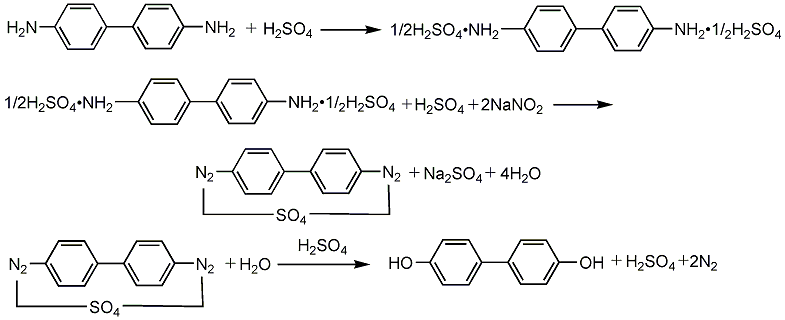
2..Benzidine salt diazotization method: Add sulfuric acid to the reaction kettle, raise the temperature to 50°C with stirring, add amine, stir and dissolve to form benzidine sulfate, then cool to below 5°C, add sodium nitrite, and dissolve the benzidine sulfate. Aniline sulfate is diazotized, and then the diazo liquid is heated to boiling and hydrolyzed under stirring, and 4,4′-dihydroxybiphenyl is precipitated. Diazotization takes 20h. It takes 4h for complete hydrolysis. The hydrolyzate is filtered while hot, then washed, dried, and then refined by sublimation to obtain the finished product. The main reaction is as follows:
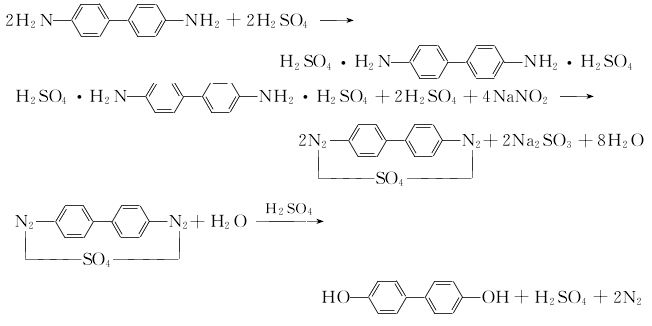
① Preparation of sodium 4,4′-dihydroxybiphenyl sulfonate. Heat 30.8g (0.2mol) biphenyl to 80℃, and use a balanced feeder at 80~100℃ in one go Add 54.0 mL of concentrated sulfuric acid with a mass fraction of 98%, raise the temperature to 160°C, hold at a constant temperature for 1 hour, cool to room temperature, and add crushed ice so that the product can be completely dissolved. Prepare 64.0g NaOH into an aqueous solution with a mass fraction of 30%, and add it to the sulfonated product while stirring. A white sulfonate will immediately precipitate; neutralize to neutral (the last 10 mL needs to be added carefully), and cool slightly to 40°C. , filter out the precipitated solid, and dry it to obtain 64.5g of product, with a yield of 90%.
② Preparation of 4,4′-dihydroxybiphenyl: 10.7g (0.03mol) recrystallized sodium 4,4′-biphenyl disulfonate, 13.5 (0.24mol) potassium hydroxide, 31.5g water Mix evenly, use a thermocouple to control the temperature to 340°C, and cool to room temperature naturally after 8 hours of reaction. Add 200 mL of water, heat to dissolve, and filter out insoluble impurities while hot; add dilute hydrochloric acid dropwise to the solution under stirring until the pH value is 4 to 5; filter out the precipitated product, and wash with cold water 2 to 3 times. Dry in the air or vacuum to obtain 4.9 g of powdered product, with a yield of 88%. Colorless flaky crystals were obtained by recrystallization using a solvent of W (ethanol): W (water) = 1:1, with a melting point of 274 to 275°C (sublimation starts from about 220°C).
Purpose
Anti-aging agent DOD is mainly used in rubber and latex. It can prevent aging caused by oxygen and heat, and also has a certain protective effect on harmful metals. It is non-polluting and can be used in light-colored vulcanized rubber products, food packaging rubber and medical latex products. It can also be used in sulfur chloride cold vulcanized products. This product can be used alone with a dosage of 0.4 to 1.5 parts, or it can be used in combination with other antioxidants. The dosage in sulfur chloride cold vulcanized rubber is 0.4 to 0.75 parts.
This product has good heat resistance and is used as a modified monomer for polyester, polyurethane, polycarbonate, polyphenylsulfone and epoxy resin to manufacture excellent engineering plastics and composite materials. As a raw material for liquid crystal polymers, it has a variety of properties and is widely used in many aspects. It can also be spun into high-strength fibers, which can be used to reinforce optical fibers and make composite materials and ropes. This product is used as a dye intermediate and can be used to synthesize photosensitive materials, etc. It is also used as an additive for petroleum products, such as a stabilizer for lubricating greases, etc.
It is an antioxidant for rubber, an important intermediate for heat-resistant engineering plastics, and a dye. Stabilizer, it is also an important precursor for the preparation of alkoxy-substituted liquid crystals. As an anti-aging agent, it is mainly used in rubber and latex. It can prevent aging caused by oxygen and heat, and also has a certain protective effect on harmful metals. It is non-polluting and can be used for light-colored vulcanized rubber products, food packaging rubber and medical latex products. It can also be used for chlorinated sulfur coldIn vulcanized products. It can be used alone with a dosage of 0.4 to 1.5 parts; it can also be used in combination with other antioxidants. Due to its good heat resistance, it can also be used as a modified monomer for polyester, polyurethane, polycarbonate, polyphenylsulfone and epoxy resin to manufacture excellent engineering plastics and composite materials. It can also be spun into high-strength fibers, which can be used to reinforce optical fibers and make composite materials and ropes. Used as dye intermediate, can synthesize photosensitive materials, etc.
extended-reading:http://www.mimgu.com/archives/44304extended-reading:https://www.bdmaee.net/2114-2/extended-reading:https://www.cyclohexylamine.net/thermal-catalyst-polyurethane-delayed-thermal-catalyst/extended-reading:https://www.bdmaee.net/fascat2001-catalyst-cas301-10-0-stannous-octoate/extended-reading:http://www.mimgu.com/archives/44906extended-reading:https://www.cyclohexylamine.net/polyurethane-gel-type-catalyst-dabco-low-odor-catalyst/extended-reading:https://www.cyclohexylamine.net/polyurethane-tertiary-amine-catalyst-catalyst-r-8020/extended-reading:https://www.bdmaee.net/nt-cat-la-200-catalyst-cas10317-48-7-newtopchem/extended-reading:http://www.mimgu.com/archives/1902extended-reading:https://www.cyclohexylamine.net/2-2-dimethylaminoethylmethylamino-ethanol-nnn-trimethylaminoethylethanolamine/
]]>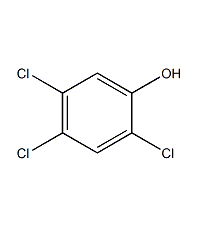
Structural formula
| Business number | 02A8 |
|---|---|
| Molecular formula | C6H3Cl3O |
| Molecular weight | 197.45 |
| label |
2,4,5-Trichlorophenol, 2,4,5-Trichlorophenol, 2,4,5-Trichloro-1-hydroxy-benzene, Aromatic halogen derivatives |
Numbering system
CAS number:95-95-4
MDL number:MFCD00002170
EINECS number:202-467-8
RTECS number:SN1400000
BRN number:607569
PubChem number:24889473
Physical property data
1. Properties: colorless needle-like crystals or gray flakes with a strong phenol smell.
2. Density (g/mL, 25℃): 1.678
3. Relative vapor density (g/mL, air=1): 7.4
4. Melting point (oC): 68
5. Boiling point (oC, normal pressure): 246
6. Boiling point (oC, 18mmHg): Undetermined
7. Refractive index: Undetermined
8. Flash point (oC): Undetermined
9. Specific rotation (o): Undetermined
10. Autoignition point or ignition temperature (oC): Undetermined
11. Vapor pressure (mmHg, oC): Undetermined
12. Saturated vapor pressure (kPa, 72oC) : 0.133
13. Heat of combustion (KJ/mol): Undetermined
14. Critical temperature (oC): Undetermined
15. Critical pressure ( KPa): Undetermined
16. Log value of oil-water (octanol/water) partition coefficient: Undetermined
17. Explosion upper limit (%, V/V): Undetermined
18. Lower explosion limit (%, V/V): Undetermined
19. Solubility: Insoluble in water, soluble in carbon tetrachloride, alcohol, benzene, and ether.
Toxicological data
1. Acute toxicity: Rat oral LD50: 820mg/kg; Rat intraperitoneal LD50: 355mg/kg; Rat subcutaneous LD50: 2260mg/kg;
Mouse oral LD50 : 600mg/kg; mouse intravenous LD50: 56mg/kg; guinea pig oral LD50: 1mg/kg; mammal LD50: 150mg/kg;
2. Other multiple dose toxicity: rat oral TDLo: 98mg/kg/98D-C;
3. Chronic toxicity/carcinogenicity
Mouse skin contact TDLo: 6700mg/kg/16W-I;
4. Reproductive toxicity
Oral TDLo in mice: 4mg/kg (8-12 days after conception in female mice);
5. Mutagenicity
Microbiology Salmonella typhimurium mutation: 10μg/plate;
Cytogenetic analysis of hamster ovary: 150mg/L;
Ecological data
This substance is harmful to the environment and it is recommended not to let it enter the environment.
Molecular structure data
1. Molar refractive index: 42.81
2. Molar volume (cm3/mol): 123.7
3. Isotonic specific volume (90.2K): 329.8
4. Surface tension (dyne/cm): 50.5
5. Polarizability (10 -24cm3): 16.97
Compute chemical data
1. Reference value for hydrophobic parameter calculation (XlogP): None
2. Number of hydrogen bond donors: 1
3. Number of hydrogen bond acceptors: 1
4. Number of rotatable chemical bonds: 0
5. Number of tautomers: 3
6. Topological molecule polar surface area 20.2
7. Number of heavy atoms: 10
8. Surface charge: 0
9. Complexity: 120
10. Number of isotope atoms: 0
11. Determine the number of atomic stereocenters: 0
12. Uncertain number of atomic stereocenters: 0
13. Determine the number of chemical bond stereocenters: 0
14. Number of uncertain chemical bond stereocenters: 0
15. Number of covalent bond units: 1
Properties and stability
1. Avoid contact with oxidants, acid anhydrides, and acid chlorides.
2. It is highly toxic and highly irritating if swallowed or inhaled. Can be poisoned by absorption through the skin. The oral dose for rats is LD50820mg/kg, and the oral dose for guinea pigs is LD501000mg/kg.
Storage method
1. Store in a cool, ventilated warehouse. Keep away from fire and heat sources. Protect from direct sunlight. The packaging is sealed. They should be stored separately from oxidants, acid anhydrides and acid chlorides, and avoid mixed storage. Equipped with the appropriate variety and quantity of fire equipment. Suitable materials should be available in the storage area to contain spills.
2. The wooden box outside the glass bottle is lined with padding or an iron drum. Store in a cool, ventilated warehouse; load and unload with care when handling to prevent damage to the container.
Synthesis method
Put 2,3,5,6-tetrachlorobenzene, solid alkali, and methanol into the autoclave, control the temperature at 135-152°C, and the pressure at 0.5-1.4MPa, and keep it for 14 hours. The reaction solution is cooled to 60°C, methanol is recovered by distillation, the residual liquid is released, cooled for crystallization, and filtered. Dissolve the crystals in water, heat to 70°C, add insurance powder, adjust pH = 9.2-9.6, add activated carbon, and decolorize at 95°C for half an hour. Filter, cool the filtrate to below 15°C, add hydrochloric acid to pH=2-3, filter out 2,4,5-trichlorophenol, and dry at 45°C to obtain the finished product.
Purpose
Used as fungicide and gas chromatography comparison sample.
extended-reading:http://www.mimgu.com/archives/1031extended-reading:https://www.bdmaee.net/fascat9102-tertiary-amine-catalyst-triisocrylate-butyl-tin-arkema-pmc/extended-reading:http://www.mimgu.com/archives/category/products/page/157extended-reading:http://www.mimgu.com/archives/44701extended-reading:http://www.mimgu.com/archives/44834extended-reading:https://www.bdmaee.net/wp-content/uploads/2022/08/stannous-octoate-CAS-301-10-0–T-9.pdfextended-reading:https://www.morpholine.org/jeffcat-zf-10/extended-reading:https://www.morpholine.org/category/morpholine/page/6/extended-reading:https://www.bdmaee.net/drier-butyl-tin-oxide-fascat-4101/extended-reading:https://www.bdmaee.net/wp-content/uploads/2022/08/134-2.jpg
]]>